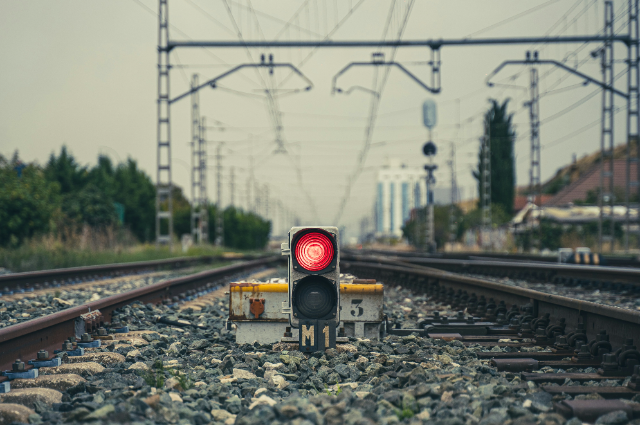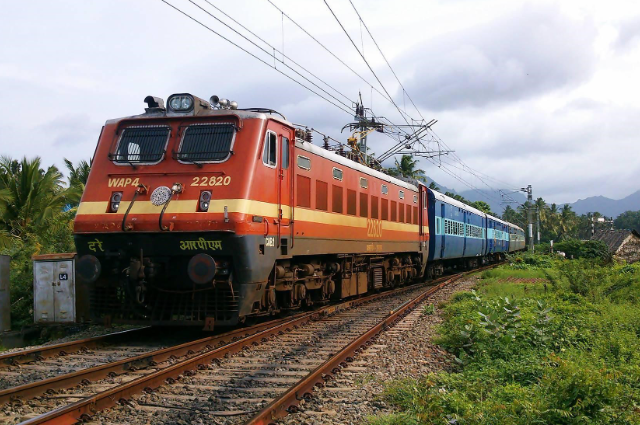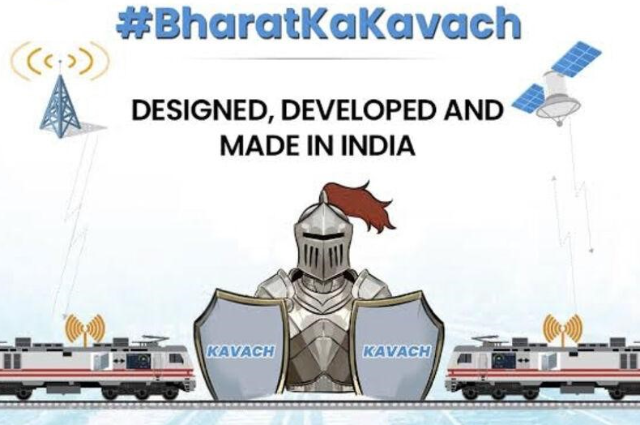
Photo by DaYsO on Unsplash
A devastating train accident occurred on Monday in West Bengal resulting in the loss of at least nine lives, including two railway staff members. The Kanchanjunga Express travelling from Agartala to Sealdah was struck by a container train, causing four coaches to derail and leaving 32 people injured.
Accident Details
The accident took place at approximately 8:55 a.m. near Rangapani station in West Bengal's Darjeeling district about 10 km from New Jalpaiguri station. The container train carrying goods, collided with the stationary Kanchanjunga Express causing significant damage to the rearmost coaches. The impact was so severe that one of the coaches was flung into the air, while the last three coaches were distorted beyond recognition.
Initial Investigation and Response
According to Railway Board Chairman Jaya Verma Sinha, preliminary investigations suggest that the driver of the goods train disregarded the signal leading to the tragic accident. The rescue operation began immediately after the accident with an Accident Relief Medical team and senior officials from New Jalpaiguri and Katihar rushing to the site. Union Railways Minister Ashwini Vaishnaw also visited the accident site, assuring a thorough probe by the Commissioner of Railway Safety.
Consequences and Aftermath
The accident resulted in the cancellation of 19 trains on the New Jalpaiguri, Siliguri Junction, Bagdogra and Aluabari Road routes. The Indian Railways is working to restore train services with a focus on clearing the railway tracks and ensuring the safety of passengers. The rescue operation has been completed and the injured are receiving medical attention.
Reactions and Concerns
The accident has raised concerns about railway safety with many questioning the effectiveness of safety measures in place. West Bengal Chief Minister Mamata Banerjee criticized the central government for its alleged negligence towards the railways while the Tripura government has sent a team to assist the injured passengers from the state.
The Kanchanjunga Express accident is a sobering reminder of the importance of prioritizing safety in our transportation systems. As investigations continue, it is crucial to identify the root causes of the accident and take necessary steps to prevent such tragedies in the future. Our thoughts are with the families of the victims and the injured, and we wish them a speedy recovery.
Ex-Gratia Payments and Support

Photo by micheile henderson on Unsplash
Prime Minister Narendra Modi announced an ex-gratia payment of Rs 2 lakh from the Prime Minister's National Relief Fund (PMNRF) for the next of kin of each deceased in the railway mishap in Bengal. The injured would be given Rs 50,000. Vaishnaw announced an enhanced ex-gratia compensation of Rs 10 lakh in the case of death, Rs 2.5 lakh for those with serious injuries and Rs 50,000 for those with minor injuries. Tripura Chief Minister Manik Saha stated that the state government has declared Rs 2 lakh ex-gratia for the next of kin of those who died. Assam Chief Minister Himanta Biswa Sarma expressed concern about the passengers since the train passes through Assam, stating, "There will be many passengers from Assam. We are waiting for details."
The Kanchanjunga Express accident is a sobering reminder of the importance of prioritizing safety in our transportation systems. As investigations continue, it is crucial to identify the root causes of the accident and take necessary steps to prevent such tragedies in the future. Our thoughts are with the families of the victims and the injured and we wish them a speedy recovery.
The Kanchanjunga Express Crash: A Timeline of Events
On 17th June Monday morning, a devastating collision occurred between a cargo train and the Kanchanjunga Express in north Bengal, resulting in loss of life and injury. Railway officials have attributed the crash to human error. Let's examine the sequence of events leading up to the tragedy.
The Journey Begins
On Sunday, a goods train departed from Amingaon, Assam, bound for Jharsuguda, Odisha. Meanwhile, the Kanchanjunga Express carrying around 1,400 passengers left Sabroom station in southern Tripura on Monday at 6:20 am, heading towards Sealdah.
Technical Snag and Safety Protocols
At 5:50 am on Monday, a technical issue affected the automatic signal system between Ranipatra railway station and Chattar Hat Junction in West Bengal. In response, officials issued a TA/912 authorization allowing train drivers to cross red signals under certain conditions. This included reducing speed and waiting for a specified time before each signal.
The Crash
At 8:27 am, the Kanchanjunga Express crossed Rangapani station slowing down to the lowered speed limit as per protocol. Shortly after, the goods train (GFCJ) left Rangapani, travelling faster than the permitted 10 km/h speed limit. At 8:55 am, the goods train collided with the Kanchanjunga Express near Rangapani, derailing several coaches.
Rescue Efforts
Locals from nearby villages rushed to the site at 9:00 am, followed by rescue teams from the National Disaster Response Force (NDRF) and the army. Together, they worked to extract trapped passengers from the wreckage. This tragic incident highlights the importance of adhering to safety protocols and addressing human error to prevent such accidents in the future.
Major train accidents that have happened in the past
Here are some of the major train accidents that have occurred in the last year:
- On June 2, 2023, the Coromandel Express collided with a stationary goods train in Balasore, Odisha, resulting in 296 casualties.
- On October 11, 2023, six coaches of the Anand Vihar Terminal-Kamakhya Junction North East Express derailed near Raghunathpur Railway Station in Buxar, Bihar, resulting in four casualties.
- On October 29, 2023, the Visakhapatnam-Rayagada passenger train derailed after colliding with the Visakhapatnam-Palasa train in Vizianagar district, Andhra Pradesh, resulting in 14 casualties.
Rail Safety in Question: West Bengal CM Mamata Banerjee Slams Centre
West Bengal Chief Minister Mamata Banerjee strongly condemned the Centre's handling of the Railways, citing the lack of anti-collision devices, fare hikes, and neglect of passenger amenities and employee welfare. Her remarks came in the wake of a recent rail accident.
Neglect and Mismanagement
Banerjee accused the Centre of neglecting the Railways, stating that it has become "parentless" and lost its glory. She alleged that passenger amenities have been reduced, and the absence of a Railway budget has made the system vulnerable. She criticized the focus on inaugural events, calling it a "fashion statement." The Chief Minister emphasized the need for a people-centric approach, urging the government to create a "people's Kavach" (automatic train protection system). She highlighted her own efforts as Railway Minister, introducing anti-collision devices in the Konkan Railways.
Railway Board's Response
In response, the Railway Board announced plans to implement the 'Kavach' system in Bengal. However, Banerjee remains sceptical, urging the government to prioritize people's safety and welfare over mere names and promises.
Mamta Banerjee expressed concern over the frequent accidents in North Bengal, labelling it an "accident spot." Her remarks underscore the need for urgent action to address the systemic issues plaguing the Indian Railways.
Rail Safety in Peril: Congress Slams Modi Government's Mismanagement
The Congress leadership has strongly criticized the Modi government for its "utter mismanagement" of the Indian Railways, leading to a surge in rail accidents over the past decade. Congress President Mallikarjun Kharge expressed deep anguish over the recent Kanchanjunga Express accident and slammed the government for its negligence.
Systematic Neglect
Kharge accused the Modi government of converting the Rail Ministry into a platform for self-promotion, prioritizing "camera-driven" publicity over safety and accountability. He vowed to hold the government accountable for its "criminal abandonment" of the Railways.
Rahul Gandhi Joins the Criticism
Rahul Gandhi, former Congress President, also targeted the Centre, stating that the increase in railway accidents over the past 10 years is a direct result of the Modi government's negligence. He emphasized the need for accountability and improved safety measures to prevent such tragedies.
The Congress leadership's strong condemnation of the Modi government's mismanagement of the Railways highlights the urgent need for reform and accountability. It is crucial to prioritize safety and address the systemic issues plaguing the Indian Railways to prevent further accidents and ensure the well-being of passengers.
Flush with Funds, but Safety Remains a Concern
Until 2015, Indian Railways (IR) faced a severe resource crunch, hindering its ability to build capacity and renew assets. However, with a significant increase in capital expenditure (capex) since then, the allocation for capex has grown manifold, currently standing at around 2.5 lakh crores annually. This surge in funding has alleviated financial constraints enabling Indian Railways to augment capacity and prioritize safety.
Safety as an Intrinsic Feature
Unlike road transport, railways have fixed infrastructure, allowing for exclusive control over asset creation, maintenance, and functioning. Safety is an inherent aspect of rail operations, not an add-on or external input. It must be given equal importance as speed and expanse when evaluating operational efficiency. The goal should be to achieve zero accidents.
Accident Statistics: A Mixed Bag
While statistics on accidents and casualties can be disheartening, they also reveal areas that require improvement. IR classifies accidents as 'consequential' and 'indicative'. Collisions are considered consequential, while Signal Passing at Danger (SPAD) incidents are deemed indicative. Although the overall number of accidents decreased significantly over the last decade, there has been an increase in collisions, which often result in high fatalities and injuries. In 2022-23, six collisions occurred, up from two in 2021-22. Reports indicate four major collisions have already taken place in 2023-24, highlighting the need for sustained efforts to ensure safety.
With ample financial resources available, IR must prioritize safety and strive for a zero-accident target. By acknowledging the importance of safety as an integral feature of operations, IR can work towards reducing collisions and ensuring a safer journey for passengers.
Automating Safety: Eliminating Train Collisions with Kavach
The Need for Intervention
Train collisions, often caused by human error or equipment failure, can be prevented with additional safety measures. The Indian Railways (IR) needs to provide extra support to loco pilots to prevent accidents. Advanced rail systems worldwide have successfully implemented automatic intervention systems, stopping trains in case of obstacles or potential collisions. India is now adopting a similar approach with its indigenous anti-train collision system, Kavach.
A Proven Technology
Kavach isn't a new concept; Mumbai's suburban rail system has had an automatic train protection system for over two decades. Previous projects like TCAS, AWS, AAS, and ETCS Level 2 were also explored before Kavach's development. Kavach is estimated to cost ₹1.2 crores per kilometre of track length, with allocations of ₹710 crores for 2023-24 and ₹540 crores for 2024-25.
Implementation and Rollout
The first phase of Kavach will cover 10,000 route kilometres, including the Delhi-Howrah and Delhi-Mumbai routes (3,000 route kilometres). Although sanctioned, the completion target date is unknown. IR plans to cover approximately 1,500 route kilometres annually.
A Step Towards Zero Accidents
Kavach has the potential to revolutionize rail safety in India. By automating safety measures, we can minimize human error and equipment failure, moving closer to our goal of zero accidents. With Kavach, India can join the ranks of advanced rail systems worldwide, prioritizing safety and efficiency.
Urgent Action Needed: Enhancing Rail Safety Before It's Too Late
The recent collision at Rangapani serves as a stark reminder of the importance of prioritizing safety in Indian Railways (IR). With the installation of Kavach on the entire network still in progress, IR cannot afford to wait and risk more lives. Immediate measures are necessary to prevent major accidents.
Interim Solutions
To enhance safety, IR can implement the following interim measures:
- Intensive training for frontline staff in maintenance and operations.
- Fitting locomotives with improved low-cost devices like VCDs and Dead Man's Handle.
- Reinstating SPAD (Signal Passing at Danger) as a subcategory of collisions, recognizing each instance as a potential accident.
- Filling operational vacancies and rationalizing train operations on all routes.
Conclusion
India needs a rail safety regulatory authority, like developed railway systems worldwide, to ensure accountability and enforcement of safety standards. Every life lost in a train accident overshadows IR's otherwise impressive performance. It's crucial to remember that safety is paramount and cannot be compromised. IR must act now to prevent further tragedies.
. . .
Disclaimer: The views expressed are personal and emphasize the need for urgent action to enhance rail safety. This article is based on various facts and references taken from research blogs, Media resources and studies. This article doesn't attempt to hurt any sentiments and doesn’t discriminate among any groups, gender, sex or place of birth. The author and Reflections.live team are not liable for any sort of legal action against them. By reading this blog, readers give consent that the views in this article are factual based and readers might agree or disagree with the same for which they can’t sue the author or Reflections.live team or people associated with this blog directly or indirectly, for any sort of disagreements in case they have. Further Reflections.live team and the author have high regard and respect for all opinions.
References:


